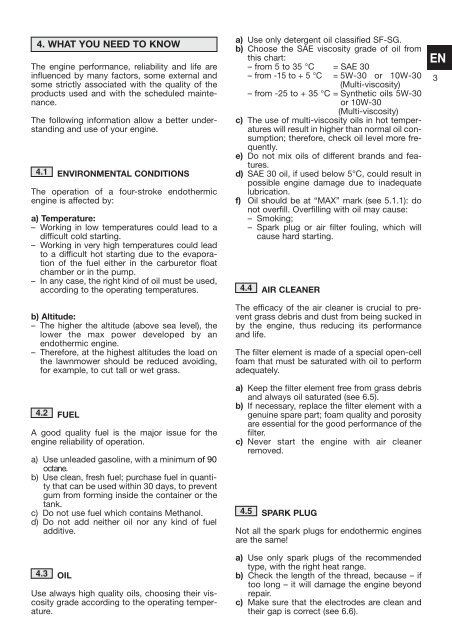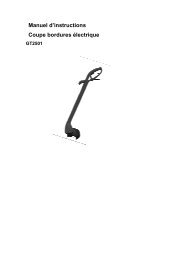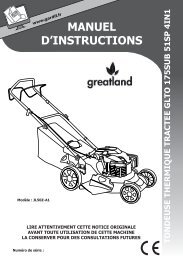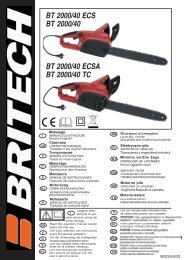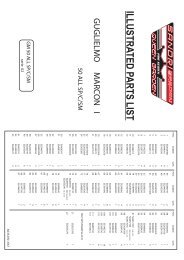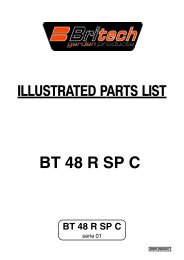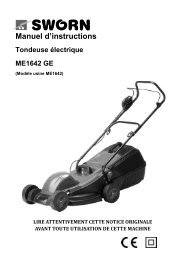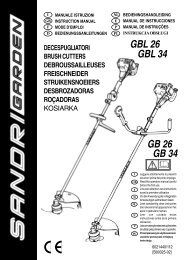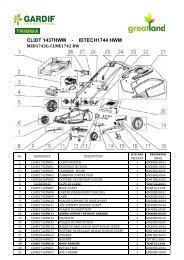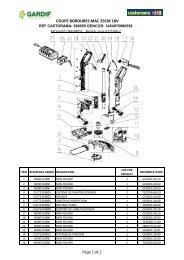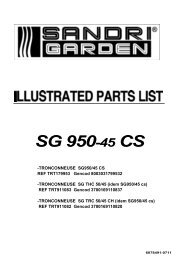motore a benzina 4 tempi manuale di istruzioni operator's manual
motore a benzina 4 tempi manuale di istruzioni operator's manual
motore a benzina 4 tempi manuale di istruzioni operator's manual
Create successful ePaper yourself
Turn your PDF publications into a flip-book with our unique Google optimized e-Paper software.
4. WHAT YOU NEED TO KNOW<br />
The engine performance, reliability and life are<br />
influenced by many factors, some external and<br />
some strictly associated with the quality of the<br />
products used and with the scheduled maintenance.<br />
The following information allow a better understan<strong>di</strong>ng<br />
and use of your engine.<br />
4.1 ENVIRONMENTAL CONDITIONS<br />
The operation of a four-stroke endothermic<br />
engine is affected by:<br />
a) Temperature:<br />
– Working in low temperatures could lead to a<br />
<strong>di</strong>fficult cold starting.<br />
– Working in very high temperatures could lead<br />
to a <strong>di</strong>fficult hot starting due to the evaporation<br />
of the fuel either in the carburetor float<br />
chamber or in the pump.<br />
– In any case, the right kind of oil must be used,<br />
accor<strong>di</strong>ng to the operating temperatures.<br />
b) Altitude:<br />
– The higher the altitude (above sea level), the<br />
lower the max power developed by an<br />
endothermic engine.<br />
– Therefore, at the highest altitudes the load on<br />
the lawnmower should be reduced avoi<strong>di</strong>ng,<br />
for example, to cut tall or wet grass.<br />
4.2 FUEL<br />
A good quality fuel is the major issue for the<br />
engine reliability of operation.<br />
a) Use unleaded gasoline, with a minimum of 90<br />
octane.<br />
b) Use clean, fresh fuel; purchase fuel in quantity<br />
that can be used within 30 days, to prevent<br />
gum from forming inside the container or the<br />
tank.<br />
c) Do not use fuel which contains Methanol.<br />
d) Do not add neither oil nor any kind of fuel<br />
ad<strong>di</strong>tive.<br />
4.3 OIL<br />
Use always high quality oils, choosing their viscosity<br />
grade accor<strong>di</strong>ng to the operating temperature.<br />
a) Use only detergent oil classified SF-SG.<br />
b) Choose the SAE viscosity grade of oil from<br />
this chart:<br />
– from 5 to 35 °C = SAE 30<br />
– from -15 to + 5 °C = 5W-30 or 10W-30<br />
(Multi-viscosity)<br />
– from -25 to + 35 °C = Synthetic oils 5W-30<br />
or 10W-30<br />
(Multi-viscosity)<br />
c) The use of multi-viscosity oils in hot temperatures<br />
will result in higher than normal oil consumption;<br />
therefore, check oil level more frequently.<br />
e) Do not mix oils of <strong>di</strong>fferent brands and features.<br />
d) SAE 30 oil, if used below 5°C, could result in<br />
possible engine damage due to inadequate<br />
lubrication.<br />
f) Oil should be at “MAX” mark (see 5.1.1): do<br />
not overfill. Overfilling with oil may cause:<br />
– Smoking;<br />
– Spark plug or air filter fouling, which will<br />
cause hard starting.<br />
4.4 AIR CLEANER<br />
The efficacy of the air cleaner is crucial to prevent<br />
grass debris and dust from being sucked in<br />
by the engine, thus reducing its performance<br />
and life.<br />
The filter element is made of a special open-cell<br />
foam that must be saturated with oil to perform<br />
adequately.<br />
a) Keep the filter element free from grass debris<br />
and always oil saturated (see 6.5).<br />
b) If necessary, replace the filter element with a<br />
genuine spare part; foam quality and porosity<br />
are essential for the good performance of the<br />
filter.<br />
c) Never start the engine with air cleaner<br />
removed.<br />
4.5 SPARK PLUG<br />
Not all the spark plugs for endothermic engines<br />
are the same!<br />
a) Use only spark plugs of the recommended<br />
type, with the right heat range.<br />
b) Check the length of the thread, because – if<br />
too long – it will damage the engine beyond<br />
repair.<br />
c) Make sure that the electrodes are clean and<br />
their gap is correct (see 6.6).<br />
EN<br />
3


